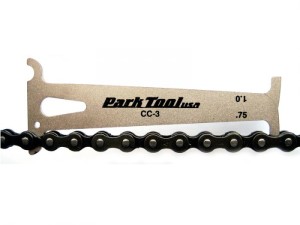 Anyone who reads my blog should know I love my bike. Not only do I save $10K a year by biking to work, I’m doing my part to help the environment. With the nice weather finally here, last week I decided to take my bike in for a yearly tune up. It had a few minor issues (the rear brakes weren’t working), but nothing major… or so I thought.
Anyone who reads my blog should know I love my bike. Not only do I save $10K a year by biking to work, I’m doing my part to help the environment. With the nice weather finally here, last week I decided to take my bike in for a yearly tune up. It had a few minor issues (the rear brakes weren’t working), but nothing major… or so I thought.
When I took in my bike to my local bike shop for an initial assessment, the salesperson took a look at my chain and noticed it was stretched and would need to be replaced. This wasn’t a surprise, since I ride my bike 10 months a year. What was a surprise was that my cassette and crank were worn and would need to be replaced, too. (Taking a bicycle maintenance is always on my to-do list, but I never seem to get around to it).
I learned a costly lesson: it’s very important to keep a close eye on your bike chain. Bike chains are rather inexpensive (I paid $25 for my last bike chain). But riding with a stretched bike chain can damage more expensive parts – mainly your crank and cassette. Not replacing your bike chain is a case of penny wise, pound foolish. By not spending $25 on a new bike chain, it can end up costing you about $100 to also buy and install a new crank and cassette.
When Should You Replace Your Chain?
 So how do you know when your chain needs to be replaced? You could take it to the bike shop, but let’s face it, most people can’t be bothered to do that. The best way is to buy a chain wear indicator. It’s a little piece of metal that measures the wear and tear on your chain. It’s rather inexpensive (I got mine for $17.99, less than a new chain). It’s simple to use. All you do is place the tool on your chain and see if it drops. If it falls flat, you need a new chain. Catching your chain before it starts damaging the other parts of your bike is vital. The tool pays for itself and is money well spent.
So how do you know when your chain needs to be replaced? You could take it to the bike shop, but let’s face it, most people can’t be bothered to do that. The best way is to buy a chain wear indicator. It’s a little piece of metal that measures the wear and tear on your chain. It’s rather inexpensive (I got mine for $17.99, less than a new chain). It’s simple to use. All you do is place the tool on your chain and see if it drops. If it falls flat, you need a new chain. Catching your chain before it starts damaging the other parts of your bike is vital. The tool pays for itself and is money well spent.
Here’s a helpful video I found on how to know when to change your chain, cassette and chainrings
When you need to replace your chains depends on how often you ride your bike. A good rule of thumb is to change your chain every 2,500 kilometers. You can figure out how long your bike ride to work is by using Google Maps. I ride my bike in the rain (but not in the snow), so I plan to check my chain once a month.
I’m a frugal guy, so why don’t I do my own bicycle repairs? Mainly time. I could probably do the repairs myself, but it would take me at least twice as long as the experts at the bike shop. I also might not do a good job (not to mention I’d be covered in grease). Even changing a flat tire can be a pain. If you don’t find the piece of glass or nail that punctured your tube, you can replace the tube and end up with a flat again in no time.
Bike Repairs: The One-Third Rule
When is your bike a goner? I use the one-third rule. If the bike repairs cost more than one third of the value of the bike, I’ll get a new bike instead. When my bike repair bill came to $200, I decided only to get minimal repairs done (under $100), since my bike is only worth $400.
Do you do your own bike repairs or take it to the bike shop?
Sean Cooper is the bestselling author of the book, Burn Your Mortgage: The Simple, Powerful Path to Financial Freedom for Canadians, available now on Amazon and at Chapters, Indigo and major bookstores, and as an Audiobook on Amazon, Audible and iTunes.
Using your bike to get somewhere in a big city is just about the most reliable and cost effective ways to get from point A to point B. Those are just some of the reasons why I love riding my bike. I’m also somewhat interested in bike mechanics, so I’ve replaced several parts on my bike myself by taking it to a community bike shop, where experienced bike mechanics can help you do repairs on your bike. My rule of thumb is, take the amount of time you think it’s going to take to repair your bike, and triple it. Don’t schedule a first date on the same night that you plan on working on your bike.
That having been said, I think that the importance that you place on changing your bike chain regularly does not apply to the majority of bike owners, and definitely should not apply to you or readers of your blog. I was wondering if I should change my chain a few weeks back and so I brought this question up with a bike mechanic. The answer: unless you’re riding a precision piece of equipment and you’re a high speed racer, you really shouldn’t worry too much about the wear on your gears caused by the bike chain.
Your bike mechanic at the shop was correct in saying that you should replace the crank, cassette and derailleur wheels if you change the chain on your bike. If you don’t, your bike chain might skip as the distance between the chain links and the teeth on the gears are no longer properly lined up with the new chain. But since you’re riding a cheap $400 bike, I wouldn’t care too much in the first place that your gears are a little worn off due to wear and tear from a stretched chain, since your main concern is with getting from point A to point B. You’re not riding a precision piece of equipment, so just wait until your chain breaks before replacing anything.
I’ve browsed the MEC website for some cheap bike parts and found you can get a crank set for $48 (http://bit.ly/28bBdfz), a 7 speed cassette for $16 (http://bit.ly/1Y88tjq) and a cheap bike chain for $12 (http://bit.ly/22F99Np). So if your chain breaks, you can get new replacement parts for under $100 if your chain breaks and the new chain won’t work with your old cassette or crank. However, I don’t think this justifies paying $12+TAX a year to replace a cheap bike chain every year in order to prevent wear and tear on a couple of cheap parts that cost less than $100 in the first place.
Perhaps most importantly though, chain wear can cost you big bucks if left too long. This is because a new chain at a 0.5in pitch is designed to sit deep into the cog. As the pitch increases, the chain rolls higher up on the tooth and causes rapidly increased cog wear as the point of contact is reduced. Too much wear, and the chain will start skipping over the top of the cog.